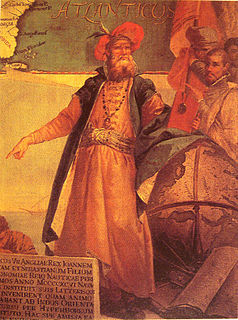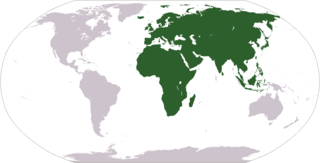 W
WThe Age of Discovery is an informal and loosely defined term for the early modern period, largely overlapping with the Age of Sail, approximately from the 15th century to the 18th century in European history, in which seafaring Europeans explored regions across the globe, most of which were already inhabited. More recently some scholars call it the Contact Period or Age of European expansion.
 W
WThis timeline of European exploration lists major geographic discoveries and other firsts credited to or involving Europeans during the Age of Discovery and the following centuries, between the years AD 1418 and 2021.
 W
WJohn Cabot was an Italian navigator and explorer. His 1497 voyage to the coast of North America under the commission of Henry VII of England is the earliest-known European exploration of coastal North America since the Norse visits to Vinland in the eleventh century. To mark the celebration of the 500th anniversary of Cabot's expedition, both the Canadian and British governments elected Cape Bonavista, Newfoundland as representing Cabot's first landing site. However, alternative locations have also been proposed.
 W
WThe Catholic Church during the Age of Discovery inaugurated a major effort to spread Christianity in the New World and to convert the indigenous peoples of the Americas and other indigenous people by any means necessary. The evangelical effort was a major part of, and a justification for, the military conquests of European powers such as Portugal, Spain and France. Christian Missions to the indigenous peoples ran hand-in-hand with the colonial efforts of Catholic nations. In the Americas and other colonies in Asia and Africa, most missions were run by religious orders such as the Franciscans, Dominicans, Augustinians, and Jesuits. In Mexico the early systematic evangelization by mendicants came to be known as the "Spiritual Conquest of Mexico".
 W
WAlthough the Norse had explored and colonized northeastern North America c. 1000 CE, the later and more well-known wave of European colonization of the Americas took place in the American continent between about 1492 CE and 1800 CE, during the Age of Exploration. During this period of time, several European empires—primarily Spain, Portugal, Britain, France, and the Netherlands—began to explore and claim the natural resources and human capital of the Americas, resulting in the displacement, disestablishment, enslavement, and genocide of the Indigenous peoples of the Americas, and the establishment of several settler-colonial states. Some formerly European settler colonies—including New Mexico, Alaska, the Prairies/northern Great Plains, and the "Northwest Territories" in North America; the Isthmus of Tehuantepec, the Yucatán Peninsula, and the Darién Gap in Central America; and the northwest Amazon, the central Andes, and the Guianas in South America—remain relatively rural, sparsely populated and Indigenous into the 21st century, however several settler-colonial states, including Brazil, Colombia, Mexico, Argentina, and the United States grew into settler-colonial empires in their own right. Russia began colonizing the Pacific Northwest in the mid-18th century, seeking pelts for the fur trade. Many of the social structures—including religions, political boundaries, and linguae francae—which predominate the Western Hemisphere in the 21st century are the descendants of the structures which were established during this period.
 W
WFactory was the common name during the medieval and early modern eras for an entrepôt – which was essentially an early form of free-trade zone or transshipment point. At a factory, local inhabitants could interact with foreign merchants, often known as factors. First established in Europe, factories eventually spread to many other parts of the world.
 W
WThe first European colonization wave began with Castilian and Portuguese conquests and explorations, and primarily involved the European colonization of the Americas, though it also included the establishment of European colonies in India and in Maritime Southeast Asia. During this period, European interests in Africa primarily focused on the establishment of trading posts there, particularly for the African slave trade. The wave ended with British annexation of Kingdom of Kandy in 1815 and founding of colony of Singapore in 1819.
 W
WThe Hunt–Lenox Globe or Lenox Globe, dating from about 1510, is the third-oldest known terrestrial globe, after the Erdapfel of Martin Behaim dating from 1492 and its identical sibling and apparent prototype, the Ostrich Egg Globe, dating from 1504. The Hunt-Lenox Globe is housed by the Rare Book Division of the New York Public Library. It is notable as one of only two known instances of a historical map actually using the phrase HC SVNT DRACONES.
 W
WMatthew was a caravel sailed by John Cabot in 1497 from Bristol to Newfoundland, North America. There are two modern replicas – one in Bristol, England and one in Bonavista, Newfoundland.
 W
WThe "New World" is a term which is applied to the majority of Earth's Western Hemisphere, specifically the Americas. The term gained prominence in the early 16th century, during Europe's Age of Discovery, shortly after the Italian explorer Amerigo Vespucci concluded that America represented a new continent, and subsequently published his findings in a pamphlet which he titled Mundus Novus. This realization expanded the geographical horizon of classical European geographers, who had thought the world consisted of Africa, Europe, and Asia, collectively now referred to as the Old World, or Afro-Eurasia. The Americas were also referred to as the fourth part of the world.
 W
WThe Old World consists of Africa, Europe, and Asia, or Afro-Eurasia, regarded collectively as the part of the world known to the inhabitants thereof before contact with the Americas. The Americas are therefore contrariwise called the New World.
 W
WDidrik Pining was a German privateer, nobleman and governor of Iceland and Vardøhus.
 W
WHans Pothorst was a privateer, likely from the German city Hildesheim.
 W
WRegio Patalis is Latin for “the region of Patala”, that is the region around the ancient city of Patala at the mouth of the Indus River in Sindh, Pakistan. The historians of Alexander the Great state that the Indus parted into two branches at the city of Patala before reaching the sea, and the island thus formed was called Patalene, the district of Patala. Alexander constructed a harbour at Patala.
 W
WThe spice trade involved historical civilizations in Asia, Northeast Africa and Europe. Spices such as cinnamon, cassia, cardamom, ginger, pepper, nutmeg, star anise, clove and turmeric were known and used in antiquity and traded in the Eastern World. These spices found their way into the Near East before the beginning of the Christian era, where the true sources of these spices were withheld by the traders and associated with fantastic tales.
 W
WHans Staden was a German soldier and explorer who voyaged to South America in the middle of the sixteenth century, where he was captured by the Tupinambá people of Brazil. He managed to survive and return safe to Europe. In his widely read True History: An Account of Cannibal Captivity in Brazil, he claimed that the native people that held him captive practiced cannibalism.
 W
WTrue History: An Account of Cannibal Captivity in Brazil is an account published by the German soldier Hans Staden in 1557 describing his two trips to the new world. The book is best known for Staden's descriptions of his experiences while held captive by the Tupinambá near Curitiba, Brazil. True History became one of the best-selling travel narratives of the sixteenth century.
 W
WBetween 1492 and 1504, Italian explorer Christopher Columbus led four Spanish transatlantic maritime expeditions of discovery to the Americas. These voyages led to the widespread knowledge of the New World. This breakthrough inaugurated the period known as the Age of Discovery, which saw the colonization of the Americas, a related biological exchange, and trans-Atlantic trade. These events, the effects and consequences of which persist to the present, are sometimes cited as the beginning of the modern era.